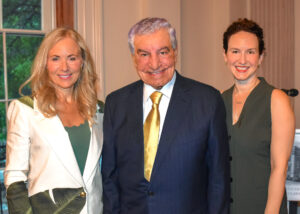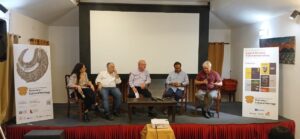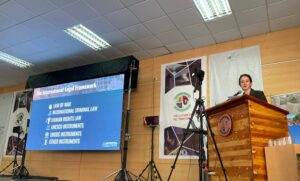“Dr. Hawass was ahead of the curve in recognizing cultural repatriation as a strategic tool to assert national identity and sovereignty on the global stage.”

“Dr. Hawass was ahead of the curve in recognizing cultural repatriation as a strategic tool to assert national identity and sovereignty on the global stage.”

For more than two decades, the U.S.–Cambodia Cultural Property Agreement (CPA) has served as a model of how cross-border cooperation can protect vulnerable heritage, keep stolen artifacts out of the U.S. market, and safeguard responsible collectors, dealers, and museums.
In 2003, the Royal Kingdom of Cambodia and the United States signed this memorandum of understanding, marking a significant step in the global fight against the illicit trade in antiquities. The agreement commits both nations to working together to combat the looting and trafficking of cultural heritage. It builds on emergency import restrictions first enacted in 1999—as Cambodia was recovering from decades of civil war, genocide, and foreign occupation.

The Antiquities Coalition was proud to join the U.S.-ASEAN Center on June 30 for the panel discussion “Advancing Regional Cooperation to Protect Cultural Heritage: Insights from the U.S.–Cambodia Cultural Property Agreement.” AC Policy Advisor Steve Epstein participated alongside leading voices in cultural heritage protection, including Glen Davis, Director of the U.S. Department of State’s Cultural Heritage Center (CHC); Emma Stein, Associate Curator of Southeast and South Asian Art at the Smithsonian National Museum of Asian Art (NMAA); Annalisa Bolin, Regional Analyst at the Cultural Heritage Center; and Deputy Chief of Mission Oum Socheat of the Royal Embassy of Cambodia to the United States.
Panelists reflected on how the U.S.–Cambodia CPA has advanced both cultural protection and international partnership. In his remarks, CHC Director Glen Davis highlighted the agreement’s success not only in deterring looting and trafficking, but also in fostering cultural exchange. Since its signing, the agreement has helped facilitate the return of over 145 stolen cultural objects, while also laying the groundwork for educational exchanges, long-term object loans, and joint exhibitions—including an upcoming Smithsonian NMAA collaborative exhibition announced during the event.
Deputy Chief of Mission Oum Socheat emphasized the shared responsibility of cultural heritage protection. He praised the CPA for demonstrating that safeguarding heritage is a “two-way street,” and urged that the lessons learned through the U.S.–Cambodia partnership should inspire similar efforts across Southeast Asia, stating,
“The United States also has a responsibility to ensure that its art market is not complicit in the trade of looted artifacts. This lesson may extend across Southeast Asia and beyond. Cambodia’s experience can inform similar efforts in our neighbors’ countries facing loss of heritage through looting and illicit trade.”
Key takeaways:
The Antiquities Coalition applauds the United States and the Kingdom of Cambodia for their sustained work to protect cultural heritage for future generations and looks forward to our continued collaboration in the fight against cultural racketeering.
Learn more about CPAs, here.
Follow the work of the U.S.-ASEAN Center.
South and Southeast Asia are emerging as powerful leaders in the global fight against cultural racketeering. Building on existing commitments, such as those by ASEAN, countries across the region continue to shape solutions to protect heritage and support communities impacted by looting and trafficking.
On June 16-18, heritage professionals came together in Lalitpur, Nepal, to issue the Lalitpur Call to International Action for the Return of Stolen Heritage, stating:
“We believe it is our common responsibility to raise the voice of the voiceless communities that have seen and continue to face loss of heritage.”
This powerful statement emerged as the key outcome of the International Conference on the Recovery of Cultural Heritage, hosted by the Nepal Heritage Recovery Campaign (NHRC) and Nepal’s Department of Archaeology in Kathmandu. The conference convened global experts, government officials, and advocates to explore how the return of sacred antiquities contributes to justice, healing, and reconciliation for communities affected by cultural plunder.
A theme across the conference: repatriation offers more than the return of stolen heritage—it creates opportunities for collaboration and sparks vital conversations about living heritage. Too often, these discussions are often missing from traditional policy debates, particularly in Asian contexts. Digging to the root of the problem, conference attendees agreed that cultural racketeering is best combated in market countries, where demand is high.
The Antiquities Coalition was honored to join these important dialogues. Through participation in panel discussions and workshops, AC Director of Programs Helena Arose engaged with partners from across the globe to advance shared solutions, highlight effective policy models, and strengthen cooperation in the fight against cultural racketeering.
The Lalitpur Call to International Action for the Return of Stolen Heritage is a rallying point for all committed to protecting cultural heritage. The declaration deserves to be shared widely—and its principles put into practice. The Antiquities Coalition encourages governments, institutions, and individuals alike to read the declaration and support the vital efforts of the Nepal Heritage Recovery Campaign.
Read the Lalitpur Call to International Action for the Return of Stolen Heritage.
The Nepal Heritage Recovery Campaign has become a global model for action. Through tireless advocacy, community engagement, and international partnerships, the NHRC has helped secure the return of dozens of sacred objects to Nepal, restoring both cultural treasures and the dignity of the communities from which they were taken. Its work demonstrates what is possible when local leadership and global solidarity align.
Learn more about the NHRC here.
A powerful wave of documentary filmmaking on cultural plunder and restitution is bringing forth new ways to share the complex realities of cultural racketeering to new audiences worldwide.
On the margins of the Nepal Heritage Recovery Campaign’s International Conference on the Recovery of Cultural Heritage (16–18 June 2025, Kathmandu), participants gathered for an extraordinary evening of film and dialogue.
At the Nepal screening, panelists and audience members alike—gripped by narratives of cultural racketeering around the globe—were awed by the humanizing depth of the film collection. Four remarkable films were featured:

Following the screenings, a panel of sector experts explored the role of law, storytelling, and repatriation in the ongoing battle against cultural racketeering. Director of Programs Helena Arose, in concert with heritage law expert Dr. James Reap, legal advocate for Cambodia Bradley Gordon, and Bibhkar Shakya, the heritage specialist leading Nepal’s recovery efforts, shared global perspectives on the successes and ongoing challenges represented in the films.
These rich case studies—brought to life by the documentaries—sparked lively audience discussion, activating collective momentum for a shared cause: protecting cultural heritage for future generations. The takeaway: films like these inspire action, build awareness, and encourage collaboration in the fight against cultural racketeering.
Explore these films and find upcoming screenings: Dahomey (2024), Have You Seen My Gods? (2025), Artifact War (2025), and LOOT: A Story of Crime and Redemption (2025)
In a recent Al Jazeera article, Executive Director Tess Davis underscored the broader implications of the pending Prakhon Chai repatriation, pointing to an enduring colonial mindset lingering in parts of the art world.
Looted from northeastern Thailand more than half a century ago, the “Prakhon Chai Hoard” includes over 100 bronze statues looted in the 1960s. Following escalating investigations into their whereabouts, the Thai government is calling for Western museums to interrogate their collections for looted artifacts and return them. The San Francisco Asian Art Museum is the first and only American museum to restitute its Prakhon Chai artifacts. With 14 more known pieces in other U.S. museums, the battle is far from over.
Met with calls for repatriation, many Western museums assume—mistakenly—that they are better carers, owners, custodians of the material past. However, as Tess says,
“These antiquities were cared for by [their] communities for centuries, in some cases for millennia, before there was … a market demand for them, leading to their looting and trafficking.”
The infamous art dealer Douglas Latchford, emerging research suggests, likely began his decades-long plunder of Southeast Asia in Thailand. Amidst ongoing investigations into Latchford’s pillage of Cambodian temples, the AC has been pleased to help bring his crimes to light, raising awareness on podcasts, through Op-Eds, on television, and in the global press.
As more museums face demands for transparency and ethical stewardship, the Antiquities Coalition welcomes this return as a hopeful step forward—and a reminder that true custodianship begins with justice.
Read the full article from Al Jazeera, here.
Dive deeper into Latchford’s criminal network, here.
Learn more about Cambodia’s recovery of its stolen heritage, here.
High-Level UN Forum, Co-Sponsored by the Antiquities Coalition, Advances Stronger Criminal Justice Responses to Cultural Racketeering
Last week, Ambassador Yasser Elnaggar, member of the Advisory Council of the Antiquities Coalition, joined leaders from government, law enforcement, and civil society for Combating Illicit Trafficking in Cultural Property: Towards Stronger Criminal Justice Frameworks. This high-level convening, co-sponsored by the Antiquities Coalition, was part of the 34th session of the Commission on Crime Prevention and Criminal Justice (CCPCJ)—the United Nations’ principal policy making body for combating crime and upholding the rule of law.

In addition to Ambassador Elnaggar, senior representatives spoke from Egypt, Cyprus, France, Greece, Italy, the United Kingdom, and the European Union, as well as the UN Office on Drugs and Crime (UNODC). These included UNODC Director-General Ghada Waly and H.E. Amira Fahmy, Egypt’s Assistant Deputy Minister of Foreign Affairs. The participation of such senior officials from across the world and key UN bodies demonstrated a broad international commitment to confronting cultural racketeering as a serious threat to global security, due to its financing of organized crime, armed conflict, and terrorism.
The May 22 event in Vienna, part of the CCPCJ’s annual meeting, marked another step forward in ongoing efforts to fight back against this illicit trade and better protect the multi-billion-dollar art market from criminal exploitation.
“The CCPCJ has a unique opportunity to make a difference on this issue,” remarked Ambassador Elnaggar. “Such action is especially needed because criminals, as always, are adapting. Today, we are confronting a broader and more complex landscape, in which cultural property is not just exploited by looters and traffickers—but for a wide range of crimes—including corruption, fraud and forgery, money laundering, sanctions and evasion, terrorist financing, and the abuse of offshore jurisdictions, shell companies, and trusts.”
As the international community looks to strengthen up its response, on behalf of the Antiquities Coalition, Ambassador Elnaggar urged the UN, CCPCJ, and all Member States to consider the following five concrete measures:
In closing the forum, Ambassador Elnaggar summed up what is at stake: “This is not just about protecting our past—it is about securing our future. The tools already exist. What we need now is the political will to use them.”
The Antiquities Coalition is grateful to have participated in the 2025 Annual Meeting of the International Scientific Committee on Archaeological Heritage Management (ICAHM), which concluded this weekend in San Pedro de Atacama, Chile.
Executive Director Tess Davis, Director of Programs Helena Arose, and Professor Emeritus Ian Lilley in their roles as co-chairs of ICAHM’s Illicit Trafficking Working Group led “Process of Plundering and Restitution of Archaeological and Anthropological Collections,” exploring how heritage crimes can be tackled through legal, ethical, and policy reform, with a specific focus on Latin America.

The panelists’ insights reaffirmed that addressing these challenges requires more than international law—it requires political will, public engagement, and regional leadership. Several key themes emerged:
The Antiquities Coalition was honored to stand alongside partners from across the Americas—and around the world—in advancing these conversations and will continue to support and amplify this work through the ICAHM Illicit Trafficking Working Group, which remains open to new members committed to protecting cultural heritage from criminal exploitation.
Watch the AC-led session Process of Plundering and Restitution of Archaeological and Anthropological Collections, here.
On May 13–14, 2015, as violent extremism tore through the Middle East and North Africa, ten nations stood together in a powerful act of resistance—not with weapons, but with a shared pledge to protect their history.
The Cairo Declaration, announced during the landmark Cairo Conference on “Cultural Property Under Threat,” marked the first regional action plan of its kind. It committed Egypt and nine other governments to coordinated efforts in combating the looting and destruction of cultural heritage—a tactic weaponized by terrorist groups like ISIS to erase identity and fund violence.
Hosted by the Arab Republic of Egypt and co-sponsored by the Antiquities Coalition, UNESCO, the Middle East Institute, and the Egyptian Ministry of Antiquities, the conference was attended by ministers, global heritage experts, law enforcement, archaeologists, and scholars.
Key outcomes of the conference included:
One decade later, the Cairo Declaration’s commitments have served as a roadmap for countries confronting cultural racketeering—spurring policy reforms, community education, and international cooperation. Powerful examples of regional cooperation have endured from the second Culture Under Threat Conference’s 2016 Amman Communiqué to the 2021 Manama Statement of Cooperation between the US and Bahrain, and extended as far as Southeast Asia following Cambodia’s pioneering efforts at the 2022 ASEAN Summit.
As we mark the 10-year anniversary of this pivotal moment, we honor the leadership of those who stood together in 2015—and we reaffirm our shared responsibility to protect the past, for the future.
Read the Cairo Declaration, here.
Revisit insights from the #CultureUnderThreat Task Force, here.
The Antiquities Coalition is honored to participate in the 2025 Annual Meeting of the International Scientific Committee on Archaeological Heritage Management (ICAHM), now underway in Chile.
Launched at the Palacio Pereira—headquarters of the Ministry of Culture, Arts and Heritage—the conference opened with a powerful ceremony reflecting Chile’s deep cultural ties to the land and its long-standing commitment to safeguarding archaeological heritage.
The gathering convenes a diverse group of stakeholders: global experts, national authorities, Indigenous communities, and cultural institutions united by a shared goal—ensuring the protection of archaeological sites for future generations. In her opening remarks, Esther Laroche, UNESCO Regional Director for Latin America and the Caribbean, reflected that “here, the notion of heritage is not abstract: it is territory, identity, and culture.” Edgar Colque of the Council of Atacameño Peoples echoed this sentiment, asserting, “Indigenous worldviews are not frozen in the past. They are present, tied to land, and based on relationships…it is a legitimate and profound way of understanding heritage, its value, and its care.”
These insights reflect the real-world focus of this convening: finding results-driven, locally led solutions to protect cultural heritage—solutions that uphold the rule of law, national sovereignty, and respect for communities. These strategies extend beyond heritage preservation, contributing to economic growth and trade, reinforcing national and regional security, and fostering resilient communities. As a longtime advocate for practical, cross-sector collaboration, the Antiquities Coalition is proud to support this mission and contribute U.S. leadership to the effort.
Later this week, the Antiquities Coalition will host the session “Process of Plundering and Restitution of Archaeological and Anthropological Collections,” led by Executive Director Tess Davis and Director of Programs Helena Arose in their capacity as co-leads of ICAHM’s Illicit Trafficking Working Group. The session will examine how heritage crimes—from looting to money laundering—can be addressed through legal, ethical, and policy reform, with a focus on Latin America.
ICAHM 2025 offers a vital platform to carry that message forward—backed by a regional perspective, shared responsibilities, and a shared determination to protect the past from plunder.
Tune in to live updates from the conference on BlueSky and Twitter.
Revisit insights about the illicit trade in Central America, shared by Mexico’s Ambassador Javier Díaz de León at CoSP10 in 2023, here.
Read the Annual Meeting program, here.
The Gulf region is rapidly emerging as a global leader in arts, culture, and heritage—demonstrating not only its investment in preserving its own rich legacy, but also its commitment to international cooperation. This dedication was on full display at The International Forum on Cultural Heritage and Knowledge Development: Fostering a Culture of Integrated Protection, hosted in Abu Dhabi by the Department of Culture and Tourism.
Bringing together policymakers, educators, cultural heritage experts, and legal specialists from across the globe, the forum highlighted the importance of integrated, cross-sector solutions to the challenges facing cultural heritage today. Its collaborative format underscored a regional and international recognition that heritage protection is not a local issue—it is a global imperative requiring united action.

The Antiquities Coalition was honored to contribute to this important dialogue. Executive Director Tess Davis spoke on Enhancing Policy, Governance, Collaboration, and Legal Frameworks for Cultural Heritage Protection, sharing core strategies that have proven effective in the fight against cultural racketeering:
The Antiquities Coalition commends the Department of Culture and Tourism for convening such a timely and impactful forum, and looks forward to continued collaboration with partners in the Gulf and around the world to protect our shared heritage from looting, trafficking, and destruction.
Learn more about the forum, here.
The Metropolitan Museum of Art—home to thousands of cultural masterpieces from Egyptian jewels to sacred Buddhas—once again served as the resplendent backdrop for the annual Met Gala, held this year on May 5. As celebrities, fashion icons, and the cultural elite walked the red carpet in celebration of Superfine: Tailoring Black Style, the Antiquities Coalition launched the third annual Looks vs. Loot
The Looks vs Loot campaign spotlights another side of NYC’s iconic venue: the ongoing crisis of cultural racketeering. While the gala’s glamour makes headlines, behind the scenes, the Met continues to reckon with its role in the illicit antiquities trade.
In a welcome development, the Met has signaled a major shift in its approach. Last May, just days after the 2024 Gala, the museum announced a new plan for addressing the provenance of its collection, which includes hiring a provenance research team of four experts to audit its holdings, as well as forming a committee of 18 curators, conservators, and others to review all legal and ethical guidelines. The museum also said it would work to “convene thought leaders, advocates and opinion makers” in the field.
These efforts align with specific recommendations outlined by the Antiquities Coalition, such as launching a task force, building capacity in provenance research, strengthening best practices, and using the institution’s platform both to raise awareness of the problem and to find solutions. Since the announcement, the museum has indeed appointed the first-ever head of provenance, who leads a team of 10 full-time researchers.
Take a look at our third annual Looks vs. Loot feature, where we draw striking comparisons between couture looks and contested antiquities—all now returned home to their country of origin. Nearly all these repatriations occurred within the last year, demonstrating strong cooperation and a will to right past wrongs.
For the 2025 Gala, celebrities and stylists showcased garments “Tailored for You”. The dress code was interpreted widely, but at its core recalls the monumental impact of small, meticulous changes. In that spirit, we extend our call on the Met to tailor its provenance policies to reflect its public commitments by proactively addressing contested antiquities and setting a gold standard for museum transparency and accountability worldwide.
While the Met has made promising strides, there’s still a need for continued refinement and implementation of its plan to fully realize its excellent goals moving forward.
For instance, there is an opportunity for greater proactivity—experts like the ICIJ have identified over 1,000 artifacts in the Met’s collection linked to alleged traffickers, and the museum should actively address these concerns. Transparency is another area for growth. The Met’s “Repatriated Objects” webpage, for example, does not appear to be fully up to date, despite growing public interest in this issue. By continuing to tailor its policy and embrace transparency, the Met—and its many contemporaries—have the potential to raise awareness of the harms of antiquities trafficking while celebrating the remarkable progress being made.
Cambodia’s cultural heritage has long been a target for looters and traffickers. In the aftermath of conflict and colonization, countless sacred sites and national treasures were stripped bare—sold to the highest bidder and often smuggled out of the country under a veil of secrecy.
A powerful new documentary, Loot: A Story of Crime & Redemption, by filmmaker Don Millar, dives into these crimes and the decades-long effort to bring looted Cambodian antiquities home. The film follows the emotional and political fight for justice, documenting how looters, collectors, and complicit institutions contributed to the theft of a nation’s soul—and how the tide is finally beginning to turn.
In a recent episode of The Diplomat’s “Beyond the Mekong” podcast, Millar speaks about the making of Loot, and the remarkable individuals whose persistence helped drive this movement. Among them is Tess Davis, Executive Director of the Antiquities Coalition, who Millar praises for her unwavering determination.
“Tess Davis from the Antiquities Coalition just won’t give up,” he says. “You see a few individuals like Tess… won’t give up, and you can actually get a result.”
Tess Davis has spent nearly two decades working to expose the illicit trade in antiquities, particularly in Southeast Asia. She has played a central role in investigations, legal actions, and public advocacy that have led to historic repatriations from prominent collectors and museums to Cambodia.
Her work continues to inspire global efforts to hold traffickers accountable, repatriate stolen cultural heritage, and ensure that future generations can reclaim their past.
Listen to the “Beyond the Mekong” podcast here.
Learn more about Douglas Latchford’s criminal network here.